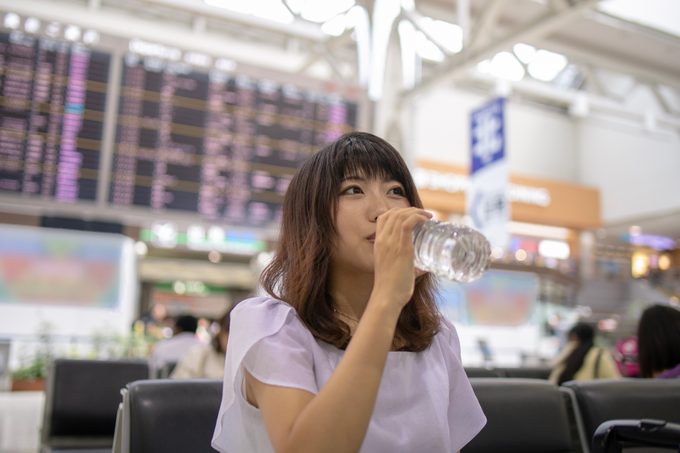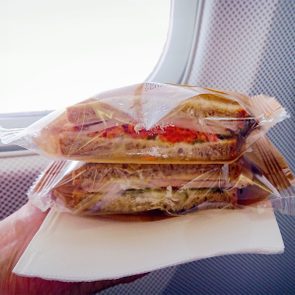There's a clever trick to bypassing the TSA's 3-1-1 rule—and it's totally aboveboard

This Is the Secret to Bringing Water Through Airport Security (Yes, It’s Possible!)

Whenever I forget there’s a bottle of water in my bag and have to toss it at a TSA checkpoint, a small part of me dies—mostly because I know a wildly overpriced replacement awaits just past security. Sadly, I’ve done this dance more times than I care to admit. But recently, I learned there’s a perfectly legitimate way to bring water through. Surprisingly, it doesn’t involve bribery, smuggling or any sneaky subterfuge—just a clever loophole in TSA’s 3-1-1 rule that may surprise you.
The best part? TSA is completely chill with it, as long as you abide by one important rule. Even Joanne Magley, director of air service, customer experience, and marketing at Daytona Beach International Airport (DAB), vouches for the travel hack. Curious? Read on.
Get Reader’s Digest’s Read Up newsletter for more travel, tech, humor, cleaning and fun facts all week long.
Is the 3-1-1 liquid rule still in place?
The 3-1-1 rule is still very much a thing, so it may come as a surprise to learn that water can go through checkpoints in carry-ons. Put in place in 2006 after British authorities foiled a terrorist plot to use liquid explosives in soft-drink bottles on transatlantic flights, the rule limits liquid to 3.4 ounces (100 ml) of liquids, gels or aerosols in travel-size containers. These must all fit into a single clear, quart-sized bag, with just one bag allowed per passenger. Anything over 3.4 ounces must go in checked baggage.
The 3-1-1 rule could eventually be rescinded, but don’t expect that to happen anytime soon. With the implementation of high-tech Computed Tomography (CT) scanners, which analyze how liquids absorb X-rays to identify the safety of their contents, TSA may eventually relax liquid restrictions in the future. But with thousands of security lanes to equip across 430 airports in the United States, that could take time—likely until 2040, according to TSA.
How can you take water through airport security?

Believe it or not, there’s a simple and totally legit way to bring more than 3.4 ounces of liquid through security checkpoints. According to TSA, “Frozen liquid items are allowed through the checkpoint as long as they are frozen solid when presented for screening.”
Magley swears by this method. “I get my ice right before going through the screening checkpoint,” she explains. “At Daytona Beach International Airport, the average screening time is 5 minutes or less, so you can get through before the ice melts. Then, when you add water, you have nice, ice-cold water for your trip!”
What’s more, Magley points out, the 3.4-ounce rule doesn’t apply to ice. “There are no limits as long as items are frozen solid.”
Do you have to let TSA know you’re bringing it through?
No. TSA agents don’t need to be alerted as long as the liquid is frozen solid. That said, it never hurts to mention it. And it’s also important to note that checkpoint officers always have the final word on whether an item can pass through security or not.
What will happen if the ice starts melting?
This is where things get dicey. If a frozen liquid is starting to melt, becoming slushy or pooling at the bottom of its container, TSA rules kick in. That means agents will require your now-not-so-frozen liquid to meet the 3-1-1 rule, meaning it can’t exceed 3.4 ounces.
What’s your best shot of having this work?
To avoid irritating TSA agents (and avoid frosty looks from travelers behind you), make sure to pack your frozen liquid in the right container. “An insulated, spill-proof cup is the best way to keep frozen liquids solid,” Magley advises. “After you get through the TSA checkpoint, it’s OK if your ice begins to melt, but you’ll want to make sure the container is leak-proof!”
What other items can you do this with?
Water isn’t the only beverage this works well with. Magley also uses this travel trick on frozen juices, lemonade and other non-carbonated drinks, especially when she has a long flight ahead of her. “As long as the liquid freezes solid, it’s OK to bring through the TSA checkpoint,” she says. “It’s a great way to have ice-cold beverages without having to buy them.”
That said, you should probably skip the soda. It can technically freeze, of course, and you might be OK—but the key word there is might. The freezing and unfreezing process could potentially cause the liquid to expand and possibly burst out of the bottle; plus, the soda may get flat.
What if you have a child who needs more than 3.4 ounces of juice, formula or breast milk during a flight and you don’t want to freeze it? Don’t worry—if that child is traveling with you, larger quantities of those liquids will be exempt from the 3-1-1 rule.
RELATED:
- Airline Passengers Are Reportedly Doing This 40% More Frequently—And Flight Attendants Aren’t Having It
- Traveling to This Airport? Be Prepared for Lost, Damaged or Delayed Luggage
- These Are the Top 10 Busiest Airports in the World
About the expert
|
Why trust us
Reader’s Digest has published hundreds of travel stories that help readers explore the world safely, easily and affordably. We regularly cover topics such as the best places to visit (and the best times to visit them), tips and tricks to zoom through airport security, flight-attendant secrets, hotel-room hacks and more. We’re committed to producing high-quality content by writers with expertise and experience in their field in consultation with relevant, qualified experts. We rely on reputable primary sources, including government and professional organizations and academic institutions as well as our writers’ personal experiences where appropriate. We verify all facts and data, back them with credible sourcing and revisit them over time to ensure they remain accurate and up to date. Read more about our team, our contributors and our editorial policies.
Sources:
- TSA: “Liquid, Aerosols, and Gels Rule”
- Travel + Leisure: “Liquid Limits for Flying Will Likely Be in Place Until at Least 2040, TSA Says”
- The Guardian: “Mass Murder Terror Plot Uncovered”
- TSA: “Ice”
- Joanne Magley, director of air service, customer experience, and marketing at Daytona Beach International Airport; email interview, May 2025























